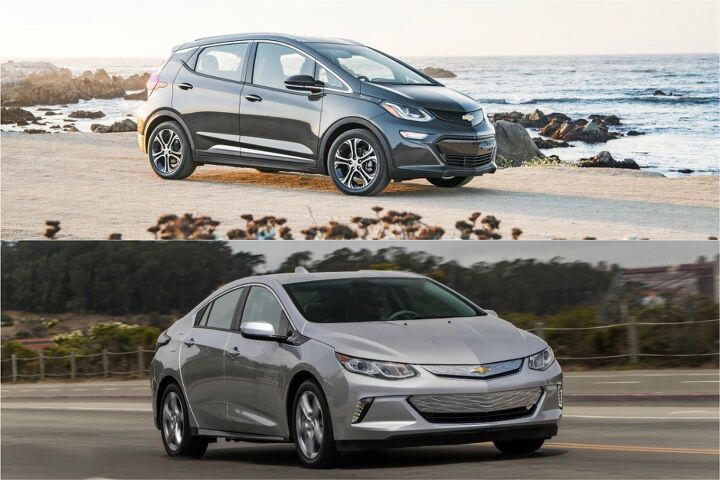Confirmed: Chevrolet's Bolt Loses Its Full Tax Credit In April, but Not the Doomed Volt

Good news for would-be Volt owners? Not really. Chevrolet’s soon-to-be-discontinued plug-in hybrid won’t live long enough to suffer the indignity of a halved federal EV tax credit. It’s dead in March, though remaining examples of the car everyone should want will no doubt linger on lots through the spring.
On Wednesday, General Motors announced, as expected, that it became the second automaker to pass the federal government’s 200,000-vehicle threshold, kicking off a three-month countdown to a chopped incentive.
The momentous moment came near the end of 2018, Automotive News reports, meaning a full quarter must pass before buyers stand to lose the $7,500 incentive offered on the all-electric Chevrolet Bolt and Volt. Come April, Bolt and remaining Volt buyers stand to receive just 3,750 of their fellow taxpayers’ dollars. Six months after that, the credit halves again, then vanishes.
Of course, General Motors execs probably aren’t toasting this green car milestone, as, much like Tesla (and Mitsubishi in Ontario), it will now have to resort to sweetening the MSRP pot on the manufacturer side. Then again, depending on the Bolt’s profitability, maybe a customer disincentive is a good thing for GM finances.
After passing the 200,000-eligible-vehicle mark in July, Tesla saw its full tax credit disappear on New Year’s Day, forcing the company to slash stickers by $2,000 across the board. Next in line to start the countdown is Nissan.
In base LT guise, the Bolt uses federal generosity to lower its MSRP five bucks below the $30k barrier. A halved credit puts the Bolt LT’s base price at $33,745. The improved 2019 Volt, condemned to death via falling sales (an affliction shared with its Detroit-Hamtramck Assembly factory mates) retails for $34,395 after delivery but before the $7,500 credit. It’s because of the Volt’s generous, 53-mile range that the car, which still packs a 1.5-liter four-cylinder for longer trips, qualifies for the full kitty.
Despite claiming its future lies in electric propulsion and computer control, GM’s short-term worries must lie with competitors who fall well below the tax credit threshold — most notably Hyundai, whose Kona EV crossover goes 258 miles between turns at the plug. Entry price for that vehicle, after incentives? An attractive $28,950.
[Image: General Motors]

More by Steph Willems
Latest Car Reviews
Read moreLatest Product Reviews
Read moreRecent Comments
- UnoGeeks Great information. Unogeeks is the top SAP ABAP Training Institute, which provides the best SAP ABAP Training
- ToolGuy This thing here is interesting.For example, I can select "Historical" and "EV stock" and "Cars" and "USA" and see how many BEVs and PHEVs were on U.S. roads from 2010 to 2023."EV stock share" is also interesting. Or perhaps you prefer "EV sales share".If you are in the U.S., whatever you do, do not select "World" in the 'Region' dropdown. It might blow your small insular mind. 😉
- ToolGuy This podcast was pretty interesting. I listened to it this morning, and now I am commenting. Listened to the podcast, now commenting on the podcast. See how this works? LOL.
- VoGhost If you want this to succeed, enlarge the battery and make the vehicle in Spartanburg so you buyers get the $7,500 discount.
- Jeff Look at the the 65 and 66 Pontiacs some of the most beautiful and well made Pontiacs. 66 Olds Toronado and 67 Cadillac Eldorado were beautiful as well. Mercury had some really nice looking cars during the 60s as well. The 69 thru 72 Grand Prix were nice along with the first generation of Monte Carlo 70 thru 72. Midsize GM cars were nice as well.The 69s were still good but the cheapening started in 68. Even the 70s GMs were good but fit and finish took a dive especially the interiors with more plastics and more shared interiors.


































Comments
Join the conversation
I think the truth about electric cars is more nuanced. If you ever wake up in an apartment in downtown Paris, open the window, and smell, you realize that there must be a great future for electric cars. But here in Ohio and in much of the US, they just aren't a sensible proposition.
I wonder how a certain bearded pretentious douchebag will try to spin this in the next Chevy commercial...